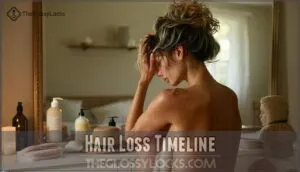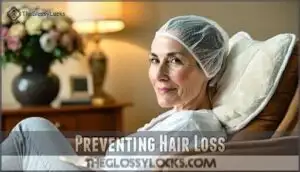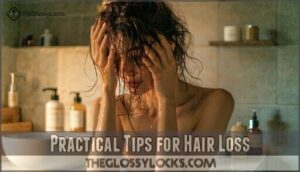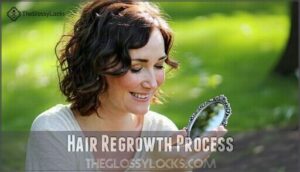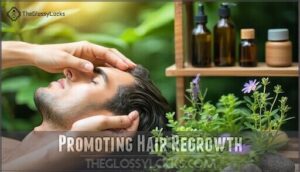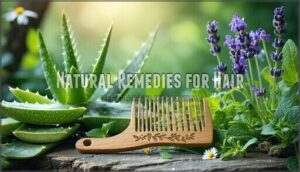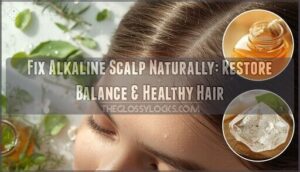This site is supported by our readers. We may earn a commission, at no cost to you, if you purchase through links.
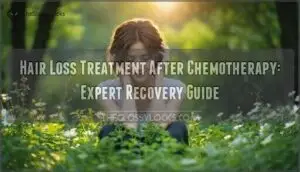
You can’t completely stop chemo-induced hair loss, but scalp cooling during treatment reduces it substantially for many patients.
Once treatment ends, your hair typically starts regrowing within 3-6 months, though it may return with different texture or color initially.
Gentle care is essential during regrowth – use mild shampoos, avoid heat styling, and protect your scalp from sun damage.
Minoxidil can accelerate regrowth, while biotin supplements support healthy hair development.
Professional treatments like low-level laser therapy offer additional options for stubborn cases.
The journey back to your pre-treatment hair involves patience, proper nutrition, and understanding that each person’s timeline differs based on treatment intensity and individual factors.
Table Of Contents
- Key Takeaways
- Causes of Hair Loss
- Hair Loss Timeline
- Preventing Hair Loss
- Managing Hair Loss
- Hair Regrowth Process
- Promoting Hair Regrowth
- Hair Loss Treatment Options
- Natural Remedies for Hair
- Professional Hair Restoration
- Maintaining Hair Health
- Frequently Asked Questions (FAQs)
- What Are The Causes of Hair Loss?
- Why Will I Lose My Hair During Cancer Treatment?
- When Will I Begin to Lose My hair?
- When Will My Hair Grow back?
- What to do when hair is falling out from chemo?
- What is the best treatment for hair growth after chemotherapy?
- What vitamins are good for chemo hair loss?
- How to care for a bald head after chemo?
- How to thicken hair after chemo?
- How to cope with hair loss from chemo?
- Conclusion
Key Takeaways
- Your hair typically starts falling out 2-4 weeks after chemotherapy begins and continues throughout treatment, but you’ll see new growth within 3-6 months after finishing chemo
- You can’t completely prevent hair loss, but scalp cooling systems during treatment can save 50-70% of your hair, and gentle care practices help minimize damage
- Minoxidil treatment started 4 weeks after chemotherapy ends can speed up regrowth significantly, reducing hair loss duration from 137 days to just 87 days
- Your new hair may look different initially with changes in texture, color, or curl pattern, but these typically return to normal over the 12-18 month full recovery timeline
Causes of Hair Loss
Understanding what causes your hair to fall out during cancer treatment helps you prepare for the journey ahead.
Chemotherapy drugs target rapidly dividing cells throughout your body, including the healthy hair follicle cells that produce your hair.
Chemotherapy Effects on Hair
Chemotherapy creates cellular damage by targeting rapidly dividing cells, including hair follicles.
This triggers anagen effluvium, causing diffuse hairloss across your scalp during the active growth phase.
Chemotherapy-induced alopecia (CIA) affects most patients, though drug variations influence severity.
Newer targeted therapies cause less chemo hair loss than traditional chemotherapy alopecia treatments.
Radiation Therapy Impact
Radiation therapy causes hair loss differently than chemotherapy.
When radiation targets your head or neck area, it damages hair follicles within the treatment field.
Radiation dosage and fractionation effects determine severity – higher doses cause more extensive hair loss.
Targeted radiation affects only treated areas, unlike chemotherapy’s widespread impact.
Hair regrowth depends on radiation intensity, though long-term effects may include permanent thinning or patchy regrowth patterns, and the overall impact is influenced by the treatment field.
Hormonal Changes and Hair
Your body’s hormone imbalance during cancer treatment creates a perfect storm for hair loss causes beyond chemotherapy alone.
Estrogen levels plummet while androgen impact increases, disrupting your hair’s natural cycle.
Thyroid function often shifts, affecting post-menopause hair patterns.
These hormonal changes compound hair loss after chemotherapy, requiring targeted hair loss treatment addressing multiple factors simultaneously for effective hair regrowth after chemo.
Hair Loss Timeline
Understanding when hair loss happens during chemotherapy helps you prepare for this common side effect.
Hair typically starts falling out within 2 to 4 weeks after your first treatment session, with the process continuing throughout your entire treatment period, which is a key aspect to consider when preparing for chemotherapy.
When Hair Loss Begins
The unpredictability of cancer hair loss catches many off guard.
Your hair loss timeline after chemotherapy typically follows a predictable pattern, though individual variation affects when initial shedding begins.
Most people notice the first signs of chemo hair loss within two to four weeks of treatment start.
- Week 1-2: Scalp may feel tender or sensitive before noticeable thinning occurs
- Week 2-4: Initial shedding becomes apparent during washing or brushing
- Week 3-5: Hair loss after chemotherapy accelerates, with clumps falling out
- Week 4-6: Loss timeline reaches peak intensity across scalp and body
- Throughout treatment: Cancer hair loss continues until chemotherapy ends, with hair regrowth after chemo beginning months later
Rate of Hair Loss
Hair loss patterns vary dramatically between patients experiencing chemo hair loss.
Some notice gradual thinning onset over weeks, while others face rapid shedding speed with hair falling in large clumps during washing or brushing.
Body hair typically follows scalp loss patterns.
The unpredictable nature of chemo baldness makes each person’s journey unique, requiring flexible hair loss solutions.
Duration of Hair Loss
Your hair will continue shedding throughout your entire chemotherapy treatment and for several weeks afterward.
Hair loss doesn’t stop when chemo ends—expect continued shedding for weeks after your final treatment.
The Shedding Timeline varies, but most people experience hair regrowth after chemo within three to six months after their final session.
Treatment Length directly affects Recovery Variance – longer chemotherapy courses may result in extended Regrowth Delay.
Remember, temporary hair loss is common, and chemo hair recovery follows predictable patterns for most patients.
Preventing Hair Loss
While you can’t guarantee complete prevention of chemotherapy-induced hair loss, several proven methods can substantially reduce the amount you lose.
Scalp cooling systems, gentle hair care practices, and specific medications offer your best defense against extensive hair loss during treatment.
Scalp Cooling Methods
Scalp cooling methods offer your best defense against chemo hair loss, though they’re not foolproof.
These cooling cap systems reduce blood flow to hair follicles during treatment, potentially saving 50-70% of your hair.
- Ice-cold caps hugging your scalp like a protective helmet during each infusion session
- Automated systems maintaining precise temperatures without constant cap changes every 30 minutes
- Penguin and Paxman cooling machines humming quietly beside your treatment chair
- Thick insulation wrapping around the cooling cap to maximize temperature control
- Your hair follicles basically "hibernating" while chemotherapy circulates through your body
Cooling Cap Types include manual systems requiring dry ice storage and automated FDA-approved units.
Cooling Cap Cost ranges from $200-500 monthly, often not covered by insurance.
Cooling Cap Efficacy varies by chemotherapy regimen and individual response.
Cooling Cap Risks include scalp discomfort and headaches.
Cooling Discomfort may occur but systems are generally well-tolerated.
Cold caps and scalp cooling chemo treatments work by restricting drug delivery to follicles, helping preserve hair regrowth chemo potential while managing chemo hair loss effectively.
Patients can explore cooling cap options to find the best fit for their treatment needs.
Gentle Hair Care Tips
Beyond cooling caps, your daily hair care routine becomes your best defense.
Use gentle shampoo and lukewarm water for hair washing twice weekly. Practice scalp massage with fingertips to boost circulation.
Try gentle combing with wide-tooth combs, starting from ends. Consider hair oiling with natural oils before washing.
Adopt soft styling techniques, avoiding heat tools and tight hairstyles during treatment to ensure the best results with gentle care.
Medications for Hair Loss
Several FDA-approved medications can help restore hair growth after chemotherapy.
Minoxidil treatment stands out as the most effective drug therapy for chemotherapy induced alopecia.
You’ll typically start minoxidil four weeks after finishing treatment.
This regrowth medication reduces hair loss duration from 137 days to just 87 days.
Topical minoxidil works better than chemotherapy pills for hair regrowth.
Patients can explore hair regrowth options to find the best approach for their individual needs, using minoxidil as a key treatment, which is FDA-approved and offers hair regrowth solutions.
Managing Hair Loss
While losing your hair during chemotherapy can feel overwhelming, you’re not alone in this experience.
Understanding how to cope emotionally and navigate daily challenges will help you feel more confident throughout your treatment journey, and there are practical ways to manage it.
Coping With Emotional Impact
Losing your hair hits harder than many expect.
You’re not vain for feeling upset – hair connects to identity and confidence.
Emotional support from counselors, support groups, or trusted friends helps process these feelings.
Self care through mindfulness therapy and stress management builds resilience during treatment.
Practical Tips for Hair Loss
Managing hair loss practically requires planning and gentle techniques. You’ll want to focus on comfort and protection while your hair changes.
Here are key practical steps for hair loss management:
- Hair Care: Use mild, sulfate-free shampoos and wash every 2-4 days to reduce breakage during hair regrowth after chemotherapy.
- Scalp Health: Apply gentle moisturizers and wear soft caps at night to protect tender skin and collect loose hair.
- Gentle Styling: Avoid heat tools, chemical treatments, and tight hairstyles that can damage fragile new growth.
- Hair Accessories: Choose soft headbands and silk pillowcases to minimize friction and support hair loss prevention efforts.
Hair Accessories and Wigs
When practical tips aren’t enough, hair accessories and wigs offer immediate coverage options.
Wig styles range from synthetic to human hair, providing natural-looking solutions during hair loss.
Head scarves and turban options create stylish alternatives, while hat choices protect your scalp from sun exposure.
Hair ties work well for securing hairpieces, making hair care during chemotherapy more manageable.
Understanding various wig style options can help individuals make informed decisions about their hair loss treatment.
Hair Regrowth Process
Your hair will typically begin growing back within three to six months after your final chemotherapy treatment ends.
The new growth may look different at first, with changes in texture, color, or curl pattern that usually return to normal over time.
Initial Regrowth Stage
Your hair begins its comeback journey around 3-6 months after finishing chemotherapy.
This new hair growth after chemo often surprises patients with its unique characteristics. Post-chemo care becomes essential as follicle health slowly recovers from chemo induced alopecia.
Initial regrowth typically presents these features:
- Hair texture changes dramatically – expect softer, finer strands initially
- Regrowth speed varies substantially between individuals and scalp areas
- New growth may appear gray or colorless until pigment cells recover
- Hair follicle stimulation remains weak, producing fragile new hair growth
This delicate phase requires gentle handling to support emerging follicles.
Full Regrowth Expectations
Your complete hair recovery journey spans 12 to 18 months from treatment’s end.
While early new growth appears within three to six months, achieving your pre-treatment hair density and length requires patience. Most people see significant improvement by the one-year mark, though full recovery varies by individual.
| Timeline | Hair Regrowth Milestone | What to Expect |
|---|---|---|
| 3-6 months | Initial sprouting | Soft, fine hair texture appears |
| 6-12 months | Noticeable length | Hair reaches 2-4 inches, thickens gradually |
| 12-18 months | Near-complete recovery | Hair approaches original density and strength |
The provided table outlines the expected hair regrowth milestones during the recovery period.
Factors Affecting Regrowth
Several key factors determine how quickly and completely your hair returns after chemotherapy induced hair loss.
Your individual biology plays the biggest role in hair regrowth timeline and final results.
- Hair Texture changes – Your new hair may grow back curlier, straighter, or different in color than before treatment
- Regrowth Rate varies – Younger patients typically see faster hair growth after chemo compared to older individuals
- Follicle Health status – The specific chemotherapy drugs you received affect how well your hair follicles recover
- Scalp Conditions matter – Proper scalp care and protection from sun damage support better hair loss recovery
- Hormonal Influence factors – Your body’s hormone levels and overall health impact the hair regrowth process
Understanding the hair regrowth process is essential for managing expectations and promoting healthy recovery.
Promoting Hair Regrowth
Once your hair starts returning after chemo, you can take steps to encourage healthy regrowth and protect new strands.
The right combination of nutrition, gentle scalp care, and proper hair handling will help your hair come back stronger and fuller.
Nutritional Strategies
Proper nutrition acts as your hair’s foundation during recovery.
Focus on protein intake from lean meats, eggs, and legumes since hair is primarily keratin.
Include omega fatty acids from fish and nuts for scalp health.
Nutrient rich foods like leafy greens provide iron and vitamins.
Consider biotin and vitamin supplements after consulting your doctor to support natural hair growth during your hair regrowth timeline.
Scalp Care Techniques
Your scalp needs extra attention during recovery to create the best environment for new growth.
Focus on gentle techniques that won’t irritate sensitive skin while promoting healthy circulation. Consistent massage rewrites genetic expression linked to hair growth.
- Scalp massage with fingertips increases blood flow and reduces tension
- Gentle shampoo formulated for sensitive skin prevents scalp irritation
- Hair oiling with natural oils like coconut or jojoba nourishes follicles
- Scalp exfoliation removes dead skin cells that block new hair growth
Gentle Hair Care Practices
When your hair starts returning after chemo, treat it like a newborn baby’s delicate skin.
Use mild shampoos and soft brushing techniques with a gentle hairbrush or soft brush. Sleep on silk pillowcases to reduce friction.
Always apply sun protection to your sensitive scalp. Avoid chemicals completely during this vulnerable regrowth phase.
Your hair care chemo routine should prioritize gentle, protective measures above all else.
Hair Loss Treatment Options
If chemotherapy left you with hair loss, several proven treatments can help speed up regrowth and improve hair thickness.
These options range from over-the-counter topical solutions to prescription medications that target hair follicle recovery.
Minoxidil for Hair Growth
After completing chemotherapy, minoxidil can jumpstart your hair regrowth journey.
This FDA-approved hair loss treatment typically begins four weeks post-chemo, working through follicle stimulation to boost hair thickness.
Minoxidil effects include accelerated regrowth, though scalp treatment responses vary among patients.
This proven hair growth product offers hope for chemotherapy-induced hair loss recovery.
Patients can explore hair growth products to find the best minoxidil solutions for their needs.
Biotin Supplements for Hair
Vitamin B-7 packs a punch in terms of supporting your hair’s comeback journey.
While biotin benefits aren’t guaranteed for everyone, this supplement can strengthen hair follicles and support healthy regrowth.
Consider these key points:
- Hair Growth: Biotin supports keratin production for stronger strands
- Vitamin Supplements: Work best alongside balanced nutrition and proper care
- Supplement Safety: Always get your care team’s approval before starting
Hair nutrition matters most during recovery.
Prescription Medications
When might prescription medication options become your best ally for stubborn hair loss?
Several FDA-approved treatments can jumpstart regrowth after chemotherapy drugs have completed their work.
Minoxidil treatment remains the gold standard for chemotherapy-induced hair loss, shortening baldness duration substantially.
Spironolactone offers additional support when minoxidil alone isn’t enough, and these hair loss medications provide proven regrowth therapy options, which can be considered your best ally for stubborn hair loss.
Natural Remedies for Hair
Natural remedies offer gentle support for hair regrowth after chemotherapy without harsh chemicals that might irritate your recovering scalp.
These plant-based treatments can complement your medical care team’s recommendations while providing nourishing care during the delicate regrowth phase, which is a crucial time for gentle support.
Essential Oils for Hair Growth
Several essential oils may support post-chemotherapy hair regrowth, though research remains limited.
Rosemary Oil and Lavender Oil show promising results in studies for stimulating follicles. Tea Tree oil helps maintain scalp health by reducing inflammation.
Eucalyptus Oil and Geranium oil improve circulation when diluted properly. Always dilute natural oils with carrier oils and consult your care team before using hair regrowth treatments during recovery, and remember to handle essential oils with care.
Aloe Vera for Scalp Health
Aloe vera gel provides powerful scalp soothing benefits for those experiencing chemotherapy induced hair loss.
This natural remedy reduces inflammation and promotes healing on tender scalps affected by cancer treatment.
Here are five key aloe benefits for scalp care:
- Moisturizes dry, irritated skin after scalp cooling treatments
- Reduces inflammation from harsh chemotherapy effects
- Provides antimicrobial protection against scalp infections
- Soothes burning sensations common during hair loss
- Creates ideal conditions for future hair regrowth treatments
Apply pure vera gel directly to clean scalp twice daily for maximum hair nourishment and comfort.
Aloe vera is known to support hair growth promotion efforts by improving scalp health.
Coconut Oil for Hair Nourishment
Coconut oil provides deep hair nourishment through natural fatty acids that penetrate hair shafts.
You can create simple hair masks by warming coconut oil and massaging it into your scalp for 10-15 minutes before shampooing.
This oil therapy supports hair recovery by moisturizing damaged follicles and reducing protein loss from chemotherapy-weakened strands, which is a key aspect of using coconut oil.
Professional Hair Restoration
When your hair doesn’t return as expected after chemotherapy, professional restoration treatments can help jumpstart regrowth. These advanced options work alongside your body’s natural healing process to restore fuller hair.
Low-Level Laser Therapy
Low-level laser therapy uses red light wavelengths to stimulate hair follicles damaged by chemotherapy.
These FDA-cleared devices deliver photobiomodulation directly to your scalp, potentially accelerating hair regrowth timeline.
Clinical studies show lowlevel laser therapy can improve hair density and thickness. You’ll use handheld devices or caps for 20-30 minutes several times weekly, making this hair loss treatment convenient for home use.
Platelet-Rich Plasma Treatments
PRP therapy uses your own blood’s healing power to jumpstart hair regrowth after chemotherapy.
This cell therapy concentrates platelets and regrowth factors, then delivers them through plasma injections directly into your scalp.
Here’s what makes PRP effective for chemotherapy-induced hair loss:
- Growth factor boost – Concentrated platelets release natural chemicals that wake up dormant hair follicles
- Improved blood flow – Enhanced circulation brings nutrients to weakened hair roots
- Extended growth phase – Keeps existing hairs in their active growing stage longer
- Faster regrowth timeline – May accelerate your natural hair recovery process
This platelet-rich plasma treatment shows promise, though research continues.
Hair Transplant Options
After completing all cancer treatments, hair transplantation offers a permanent solution for stubborn hair loss.
You’ll need medical clearance and a six-month waiting period before considering this option.
| Technique | Key Features |
|---|---|
| FUE (Follicular Unit Extraction) | Individual follicle transfer, minimal scarring, faster recovery |
| FUT (Follicular Unit Transplantation) | Strip removal method, linear scar, more grafts per session |
| Success Rate | 90-95% graft survival with experienced surgeons |
| Cost Range | $4,000-$15,000 depending on grafts needed |
Hair grafting works by moving healthy follicles from donor sites to thinning areas.
Transplant costs vary based on technique and graft quantity.
Surgery risks include infection and poor healing, especially after radiation therapy.
Maintaining Hair Health
Once your hair starts growing back after chemotherapy, you’ll need to adjust your care routine to protect these new, often fragile strands.
The key is being gentle with your recovering hair while supporting its continued growth and strength.
Long-Term Hair Care Tips
After professional treatments help restart your hair’s journey, maintaining long-term health becomes your daily mission.
Hair nutrition through balanced vitamins and minerals supports strong growth from within. Regular scalp massage increases blood flow while gentle shampoo protects fragile strands.
Hair oils like argan provide deep nourishment. Soft styling techniques prevent breakage during your hair growth regrowth timeline.
Avoiding Hair Damage
Your recovering hair needs protection from damage that could set back your progress.
Skip harsh chemicals like bleaching or perming for at least six months.
Use gentle shampoos and mild conditioners designed for sensitive scalps.
Soft brushes prevent breakage when detangling.
Weekly hair masks nourish fragile strands.
Regular scalp massage improves circulation without trauma.
These hair care during chemotherapy practices support healthy regrowth.
Following proper hair care tips is essential for maintaining hair health and promoting regrowth.
Emotional Support for Hair Loss
Hair loss affects more than your appearance—it impacts your sense of self.
Counseling services and support groups provide safe spaces to process these feelings.
Mental health professionals understand hair loss psychological effects and offer coping strategies.
Self care practices like mindfulness techniques help manage anxiety.
Remember, seeking emotional support shows strength, not weakness.
Frequently Asked Questions (FAQs)
What Are The Causes of Hair Loss?
Cancer treatments like chemotherapy target rapidly dividing cells throughout your body. Since hair follicles are among the fastest-growing cells, they’re particularly vulnerable to damage, causing widespread hair loss.
Why Will I Lose My Hair During Cancer Treatment?
Chemotherapy targets rapidly dividing cells throughout your body, including the hair follicles in your scalp.
Since these follicles are constantly growing new hair, they’re particularly vulnerable to the medication’s effects, causing widespread hair loss.
When Will I Begin to Lose My hair?
Like autumn leaves dropping suddenly when frost hits, you’ll notice hair starting to fall out 2 to 4 weeks after your first treatment begins.
It may come out gradually or in clumps during washing.
When Will My Hair Grow back?
Your hair will typically start growing back within three to six months after your final chemotherapy treatment ends, though regrowth varies between patients and may differ in texture or color.
What to do when hair is falling out from chemo?
Surprisingly, you can’t stop hair from falling out once chemo starts, but gentle care helps.
Use mild shampoo, avoid heat styling, wear soft caps at night, and consider scalp cooling caps if available.
What is the best treatment for hair growth after chemotherapy?
The most effective approach combines gentle care with targeted treatments. Minoxidil speeds regrowth when started four weeks post-treatment. You’ll see new growth within three to six months naturally.
What vitamins are good for chemo hair loss?
Biotin supplements may help support hair regrowth after chemo, but you’ll need your care team’s approval first. Evidence is limited, so don’t expect dramatic results from vitamins alone.
How to care for a bald head after chemo?
Caring for your newly smooth scalp requires gentle attention and protection.
Moisturize daily with fragrance-free lotion, wear sunscreen or hats outdoors, and use mild cleansers to keep skin healthy and comfortable.
How to thicken hair after chemo?
Your hair will gradually thicken as it regrows after treatment ends. Consider minoxidil to accelerate growth, gentle shampoos, and avoid harsh chemicals while your follicles recover naturally.
How to cope with hair loss from chemo?
Like knights donning armor before battle, you’ll need practical shields against this temporary challenge. Try gentle scalp care, soft head coverings, and supportive friends who understand your journey through treatment.
Conclusion
Recovery blooms like a garden after winter’s harshest frost.
Your hair loss treatment after chemotherapy journey requires patience as your body heals.
Most people see initial regrowth within 3-6 months, though texture and color may differ initially.
Focus on gentle care, proper nutrition, and proven treatments like minoxidil or biotin supplements.
Remember that each person’s timeline varies based on treatment intensity and individual factors.
With consistent care and realistic expectations, you’ll rebuild both your hair and confidence through this transformative process.
- http://faculty.mdanderson.org/profiles/deepti_chopra.html
- https://my.mdanderson.org/RequestAppointment
- https://www.cancer.org/cancer/managing-cancer/side-effects/hair-skin-nails/hair-loss/coping-with-hair-loss.html
- https://breastcancernow.org/about-breast-cancer/treatment/chemotherapy/chemotherapy-drugs/capecitabine-xeloda
- https://www.cancerresearchuk.org/about-cancer/coping/physically/changes-appearance/hair-loss/treatment

